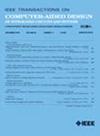Multiobjective Optimization for Common-Centroid Placement of Analog Transistors
IF 2.9
3区 计算机科学
Q2 COMPUTER SCIENCE, HARDWARE & ARCHITECTURE
IEEE Transactions on Computer-Aided Design of Integrated Circuits and Systems
Pub Date : 2024-12-19
DOI:10.1109/TCAD.2024.3520521
引用次数: 0
Abstract
In analog circuits, process variation can cause unpredictability in circuit performance. Common-centroid (CC) type layouts have been shown to mitigate process-induced variations and are widely used to match circuit elements. Nevertheless, selecting the most suitable CC topology necessitates careful consideration of important layout constraints. Manual handling of these constraints becomes challenging, especially with large size problems. State-of-the-art CC placement methods lack an optimization framework to handle important layout constraints collectively. They also require manual efforts and consequently, the solutions can be suboptimal. To address this, we propose a unified framework based on multiobjective optimization for CC placement of analog transistors. Our method handles various constraints, including degree of dispersion, routing complexity, diffusion sharing, and layout dependent effects. The multiobjective optimization provides better handling of the objectives when compared to single-objective optimization. Moreover, compared to existing methods, our method explores more CC topologies. Post-layout simulation results show better performance compared to state-of-the-art techniques in generating CC layouts.模拟晶体管共质心布置的多目标优化
在模拟电路中,工艺变化会导致电路性能的不可预测性。共质心(CC)型布局已被证明可以减轻工艺引起的变化,并广泛用于匹配电路元件。然而,选择最合适的CC拓扑需要仔细考虑重要的布局约束。手动处理这些约束变得具有挑战性,特别是对于大型问题。最先进的CC放置方法缺乏一个优化框架来处理重要的布局约束。它们还需要人工操作,因此,解决方案可能不是最优的。为了解决这个问题,我们提出了一个基于多目标优化的模拟晶体管CC放置统一框架。我们的方法处理各种约束,包括分散程度、路由复杂性、扩散共享和布局依赖效应。与单目标优化相比,多目标优化提供了更好的目标处理。此外,与现有方法相比,我们的方法探索了更多的CC拓扑。布局后仿真结果显示,与生成CC布局的最先进技术相比,性能更好。
本文章由计算机程序翻译,如有差异,请以英文原文为准。
求助全文
约1分钟内获得全文
求助全文
来源期刊
CiteScore
5.60
自引率
13.80%
发文量
500
审稿时长
7 months
期刊介绍:
The purpose of this Transactions is to publish papers of interest to individuals in the area of computer-aided design of integrated circuits and systems composed of analog, digital, mixed-signal, optical, or microwave components. The aids include methods, models, algorithms, and man-machine interfaces for system-level, physical and logical design including: planning, synthesis, partitioning, modeling, simulation, layout, verification, testing, hardware-software co-design and documentation of integrated circuit and system designs of all complexities. Design tools and techniques for evaluating and designing integrated circuits and systems for metrics such as performance, power, reliability, testability, and security are a focus.

 求助内容:
求助内容: 应助结果提醒方式:
应助结果提醒方式:


